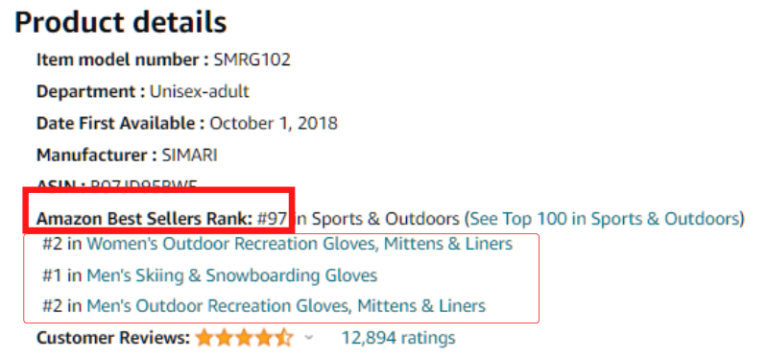Many people with an entrepreneurial drive are interested in becoming online retailers. Traditional business owners...
Many people with an entrepreneurial drive are interested in becoming online retailers. Traditional business owners and sellers are now more interested in transitioning to online business to participate in the booming eCommerce industry. In particular, entrepreneurs are increasingly interested in venturing into online arbitrage.
One of the go-to marketplaces when it comes to online arbitrage is Amazon. The increasing demand for online goods has attracted sellers worldwide to explore Amazon FBA online arbitrage.�
Understanding Online Arbitrage for Amazon
Arbitrage is generally described as purchasing an item from one marketplace at a lower price and selling it on another marketplace for a higher return.�
In its essence, arbitrage is considered a reselling activity whereby the seller searches for a product from other retail sources rather than directly dealing with suppliers. Items purchased using this method are not necessarily in bulk or huge volume.��
Simply put, arbitrage is when you flip something for a profit�the seller profits from the difference between the cost and the return of the investment.��
Online Arbitrage vs Retail Arbitrage
In the context of eCommerce, there are two main types of arbitrage that sellers engage in. Sellers have the option to go for retail arbitrage or online arbitrage for Amazon.�
Amazon Retail Arbitrage��As its name would imply, retail arbitrage is a type of arbitrage that relies on retail outlets or brick and mortar stores for product sources. Resellers will spot an item and purchase it. Sellers will handle the transportation and warehousing for purchased items.�
This kind of approach relies mainly on physical retail stores and their items for liquidation. Sellers can purchase clearance stocks at a discounted price to sell on Amazon for a higher return.�
Online ArbitrageOnline arbitrage has become increasingly popular over the past years, especially during the heights of quarantine restrictions and the closure of physical stores due to the pandemic. Many sellers turn to the online arbitrage business model for a more convenient transaction.
Online arbitrage on Amazon simply means sourcing potential inventory items from retail store websites, Facebook shops, and other eCommerce platforms.
Getting Started With Online Arbitrage | Overview for Beginners
As an overview of how online arbitrage works, here are three main steps involved in this method to help you get started with your very own successful online arbitrage business.�
STEP 1: Search for a product on other platforms or a trusted online marketplace to resell. Ensure that the product you purchase is sold for less than what it sells on Amazon.�
STEP 2: Once you find products from other online stores that you can resell on Amazon, buy them and have them shipped to your facility or the FBA warehouse.�
STEP 3: Once the product is in your inventory, list the product for sale at a price that will give you a healthy profit margin.�
The good thing about selling online via Amazon arbitrage is that you can utilize both methods for your business. There is no restriction on whether you use both online and retail arbitrage, as long as you follow the terms and conditions set by Amazon.�
However, more and more sellers are focusing their resources on online arbitrage because of easier sourcing and shipping. There is no need for Amazon sellers to spend time and money to check brick-and-mortar stores for discounted items.�
Amazon Online Arbitrage Sources
With just a click of the mouse, Amazon sellers can easily find products via online retail platforms. Here are some of the online retail websites you can check for arbitrage items:
Walmart Target Sears Best Buy Gamestop Office Depot Home Depot Lowe�s WalgreensPros and Cons of Online Arbitrage
If you are interested in starting your own Amazon FBA online arbitrage business, you should take note of the advantages and disadvantages of this sourcing method. Examine the pros and cons of online arbitrage and check whether it fits with your overall business strategy.�
Pros of Amazon Online Arbitrage�
Low Entry ThresholdIf you are at the beginning phases of your Amazon business venture, online arbitrage gives you an advantage in terms of time and monetary requirements. Unlike product sourcing overseas, online arbitrage requires less time and is also less expensive, resulting in improved profit margins.
Less TaxingIf you�re looking for convenience when it comes to product sourcing, then online arbitrage for Amazon is best for you. This method requires less physical work; all you have to do is search potential inventory items online and have them delivered.�
Location IndependentSince this business model is mostly done online, you have the liberty to do business anywhere you want around the globe. You can also take advantage of the work-from-home setting.
Extensive InventoryUnlike physical outlet stores whose products are limited, online arbitrage offers you almost unlimited options for inventory items. There are numerous online retail websites that can provide various products for your inventory.�
Cons of Amazon Online Arbitrage��
Tech AdjustmentsIf you are not familiar with using a computer or browsing the internet for products, you will likely have a steep learning curve. Moreover, there are quite a few online tools and apps that you should be acquainted with.�
Mismatch InventoryThere is a risk of having mismatched inventory since not all listings are identical across other online retail sources.�
Missed OpportunitiesSince your focus is online, you might miss out on huge outlet store promotions and discounts, especially those items for liquidations that are cheaply sold.�
The above points represent the key pros and cons of Amazon FBA online arbitrage. It is worth noting that success in online arbitrage hinges on product selection and pricing.�
The disadvantages mentioned above can be� through practice, proper application of online selling strategies, and the use of Amazon seller tools.�
Since the current consumer trend is leading towards eCommerce, online arbitrage for Amazon has become the default FBA start-up model for the majority of sellers, especially first-time Amazon sellers.��
Is Online Arbitrage Still Profitable in 2023?�
Online arbitrage remains highly relevant in 2023 because online sellers are still profiting from it. In particular, the online arbitrage revenue on Amazon can be substantially higher than other eCommerce platforms.�
Assuming that you have purchased an item from Best Buy or Walmart for $10 that is currently selling on Amazon for $35, you will likely have a 10-15 USD profit after all the fees and shipping costs have been deducted.�
In such a scenario, your investment of $10 has doubled in profit. This is how online arbitrage for Amazon works for FBA sellers.
Just to give you an idea, it is estimated that over 50% of online arbitrage sellers generate a monthly income of roughly $5,000, maintaining a profit margin of 16%.
Expenses That Affect Your Profitability�
As Amazon FBA online arbitrage sellers, you need to factor in the expenses you will incur in order to make proper pricing adjustments. Here are some of the expenses you should take into account if you wish to profit from Amazon FBA online arbitrage.�
Amazon Fees (FBA fees, storage cost) Inbound Shipping Costs Product Selling Price on Amazon The initial investment for InventoryIt is worth noting that there would always be a risk involved with starting your Amazon FBA online arbitrage venture. Success in such an undertaking requires capital, dedication, and effort to learn the basics and master the Amazon seller tools available to help you scale your business.
Online Arbitrage for Amazon FBA | How it Works
One of the reasons why online arbitrage is still popular and relevant in 2023 is its convenience. This business model is easy to learn and navigate. To help you start your online arbitrage Amazon venture, here are some key guidelines to get started.�
Find a ProductOnce you have created your Amazon FBA account, you�ll need to find a viable product. These products should be purchased for less than their selling price on Amazon or another marketplace.�
The� use of Amazon seller tools, including product research and sourcing tools will assist you in finding the most profitable items to sell on Amazon. One of the popular methods of arbitrage sellers is the UPC search. The majority of the retail websites use universal product code (UPC) on the retail product packaging for faster identification.�
For example, if you are on the Walmart retail website, you can search the UPC of an item to compare it with another item listed on Amazon. This process helps you avoid wrong comparisons of items, especially those with numerous variations, models, and presentations.�
Using UPC for Product Search
To help you find products from retail websites, you may use UPC. For example, on the Walmart website, you select an item you want and verify if it is available on Amazon, along with its pricing.
�

Walmart: A screenshot (cropped) of product detail page; Retrieved Date: July 26, 2021� from https://bit.ly/2UPe45O
�
Once you are on the product detail page of the selected item, simply right-click on the page and select VIEW PAGE SOURCE.�
�

Walmart: A screenshot (cropped) of product detail page; Retrieved Date: July 26, 2021� from https://bit.ly/2UPe45O
�
After selecting the View Page Source, you will be redirected to a different tab. Once on the tab, CTRL + F to search for the UPC.�
�

�
Once the UPC or product code has been located, copy it and paste it in the Amazon search bar. Then click search.�
�

Amazon: A screenshot (cropped) of product detail page; Retrieved Date: July 26, 2021� from https://amzn.to/3iSHwjj
�
Once the search result has appeared, click on the item that is similar to your chosen item on Walmart. You may also view the page source on the Amazon product detail page and search for the actual UPC code for further verification.�
From there on, you can compare the listing and its profitability as your potential Amazon FBA online arbitrage item. As a pro tip, consider Amazon products with a low Amazon Best Seller Ranking, as it� means they sell quickly.

Amazon.com: Screenshot (cropped) Amazon product detail page; Retrieved: Jan. 20, 2020, from https://amzn.to/3qOwQF5
�
Buy and Ship ProductsIf you have already chosen and confirmed the profitability of an item, purchase it and have it delivered to the FBA warehouse. Alternatively, if you wish to add some customization or want to check the product integrity, you may also have the product sent to your own warehouse/storage center.�
List The ProductAfter sending the product to the Amazon warehouse, list the product for sale in your Amazon account. Always remember to take into account all the expenses you have incurred when purchasing and shipping items.�
Maintain a healthy margin when listing an item on Amazon. To help you secure profit, the use of an Amazon FBA calculator and an automatic repricer is highly recommended.��
Product Categories for Successful Amazon Reselling Business�
If you are considering venturing into online arbitrage on Amazon, you must become familiar with the product categories that tend to perform well and are highly favored by other Amazon sellers. To provide you with insight, here are some product categories where Amazon sellers have products listed:
35% for Home & Kitchen
26% for Beauty & Personal Car
20% for Clothing, Shoes & Jewelry
18% for Toys & games
17% for Health, Household & Baby Care
16% for Baby
16% for Electronics
16% for Sports & outdoors
13% for Pet Supplies
13% for Office Supplies
In terms of profitability, here is a list of categories where Amazon sellers reported making higher profits:
30% profited in the Beauty & Personal Care Category
30% profited� in the Home & Kitchen Category
27% profited in the Clothing, Shoes & Jewelry Category
23% profited in the Arts, Crafts & Sewing Category
22% profited in the Electronics Category Category
21% profited� in the Sports & Outdoors Category
21% profited in� Health, Household & Baby Care Category�
20% profited in the Toys & Games Category
19% profited in the Grocery & Gourmet Food Category
17% profited in the Cell Phone & Accessories Category
Top Online Arbitrage Tools�
Undeniably, a manual product search can be laborious for most sellers. It can also lead to costly mistakes, especially when sellers are not focused on the task at hand.
To give you a better alternative, here are some of the highly suggested product sourcing tools to improve your product sourcing project.�
Tactical ArbitrageThis sourcing tool can drastically improve your Amazon product search. Its algorithm scans major department stores as well as thousands of other lesser sources that sellers neglect to check.�
Tactical arbitrage offers access to dozens of metrics and data both with basic and advanced view options. It can also scan Amazon for the historical Buy Box price and sales rank data to help you stay ahead of the competition.�
BuyBotPro�This Amazon seller tool is known in the industry as an Amazon FBA online arbitrage virtual buying assistant. Some of its features include automated deal analysis and buy decisions that can make your arbitrage transactions faster.�
It also has a competition analyzer to help you analyze competitions. Along with the eligibility checker that instantly informs sellers whether the product can be sold.��
SourceMogulIf you wish to discover the best products to sell on Amazon from other websites or retail platforms, you should check SourceMogul. This Amazon seller tool scans over 20 million products per month to help you find profitable deals.�
Many sellers are using this tool because of its speed, simplicity, and real-time Amazon sales analysis. One of the goals of this software is to make online arbitrage simpler for Amazon sellers worldwide.�
FBA WizardAs its name would suggest, this software is mainly intended to help Amazon FBA sellers with their online arbitrage sourcing needs. With their user-friendly interface, finding high-profit products to resell on Amazon is made easier.�
What makes FBA Wizard unique is its invite-only policy. Hence, providing exclusive information and deals only to a chosen few.�
Other Seller Tools to Assist your Amazon Online Arbitrage
Amazon Repricing SoftwareApart from the product research tools for online arbitrage, you should also incorporate the use of automatic AI repricer in your business. This will help you edge your competition in terms of winning the Amazon Buy Box and avoiding price wars.
Another benefit of using an AI repricer is its seller analytics and user-friendly interface. This will give you a better overview of your current pricing strategy and Amazon store success.�
Keyword Research ToolOnce you have found an item for online arbitrage, you should identify the best keywords to use for increased ranking on the search result pages of Amazon. With the help of this tool, you can incorporate keywords on your product description or listing to improve searchability and customer engagement.�
Inventory Management SoftwareThis software will help you enhance your product listing process. Softwares like InventoryLab will help you streamline your daily inventory management tasks through strong data research and analytics.
Feedback Tools�Amazon greatly values customer feedback, which is why it is included in its evaluation for ranking and awarding the Buy Box. In order to increase feedback volume from customers, a feedback tool is a must.�
With the help of this tool, reviews or feedback requests will be automated. This seller tool will send emails to previous shoppers and ask them for feedback.�
Checking Amazon Restrictions for Online Arbitrage
One of the common mistakes of Amazon sellers is purchasing numerous items without even checking if Amazon will allow you to sell them on the platform. Most sellers are blinded by the healthy profit margin and forget to check Amazon product and category restrictions.�
To avoid this, you should check whether the product or category requires approval from Amazon. For category requirements and approvals, you may CLICK HERE.
Common Reasons for Amazon Online Arbitrage Failure
Engaging in Amazon FBA online arbitrage is not a guaranteed success.Here are some of the reasons why online arbitrage can be an unsuccessful venture.�
Failure to Check Amazon Restrictions Lack of Proper Data and Insight False Expectations of Sellers Expanding Too Early and Rapidly Lack of Interest to Learn New ThingsTips on How to Grow Your Online Arbitrage Business on Amazon
Engaging in Amazon online arbitrage requires more than passion. Be sure to play by the rules and learn the ins and outs of the market.�
Carefully research the market and your competition before engaging in online arbitrage.� Develop healthy risk management when it comes to arbitrage. It means that you should not invest anything that you cannot afford to lose.� Always factor in the Amazon fees when sourcing items to resell on Amazon. Your aim is not just sales, but most importantly to obtain profit.�� Check what sells and reinvest in those items first before branching out to new products.� Take advantage of Google Chrome extensions such as Keepa and CamelCamelCamel. Both Chrome extensions offer price tracking and price history charts for Amazon products.� Consider adding a workforce when demands get high to help you gradually expand your Amazon online arbitrage business. The same goes with Amazon seller tools; consider integrating them into your business.�Start Your Online Arbitrage Business Today�
Online arbitrage is often seen as one of the easiest ways to get your online business up and running. If your goal is to break into the Amazon marketplace, starting with FBA online arbitrage is a convenient choice. The tips and insights above can help you quickly launch an arbitrage business and succeed in your Amazon venture.















